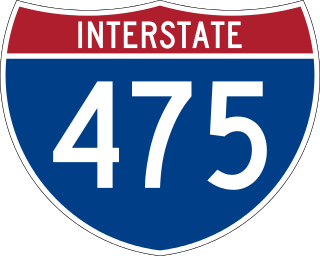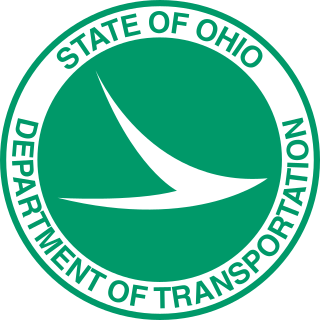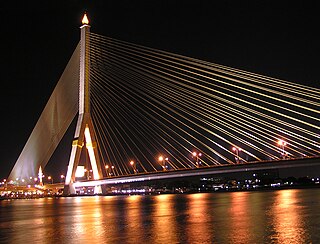
Toledo is a city in and the county seat of Lucas County, Ohio, United States. At the 2020 census, it had a population of 270,871, making Toledo the fourth-most populous city in the state of Ohio, after Columbus, Cleveland, and Cincinnati. Toledo is also the 79th-largest city in the United States. It is the principal city of the Toledo metropolitan area, which had 646,604 residents in 2020. Toledo also serves as a major trade center for the Midwest; its port is the fifth-busiest on the Great Lakes.

A cable-stayed bridge has one or more towers, from which cables support the bridge deck. A distinctive feature are the cables or stays, which run directly from the tower to the deck, normally forming a fan-like pattern or a series of parallel lines. This is in contrast to the modern suspension bridge, where the cables supporting the deck are suspended vertically from the main cable, anchored at both ends of the bridge and running between the towers. The cable-stayed bridge is optimal for spans longer than cantilever bridges and shorter than suspension bridges. This is the range within which cantilever bridges would rapidly grow heavier, and suspension bridge cabling would be more costly.

Interstate 475 (I-475) is an auxiliary Interstate Highway in Ohio that is a 20.37-mile (32.78 km) western bypass of Toledo. The southern terminus is I-75 exit 192 near Perrysburg. From the southern terminus to exit 14, I-475 is cosigned with US Route 23 (US 23) and is signed the north–south section of I-475. From exit 14 to the eastern (northernmost) terminus at I-75 exit 204 in central Toledo, it is signed the east–west section of I-475.

Interstate 280 (I-280) is a 12.41-mile-long (19.97 km) auxiliary Interstate Highway in Ohio that connects I-75 in northeast Toledo with I-80/I-90 southeast of the city in northeastern Wood County. Built between 1955 and 1959, the route was originally part of the Detroit–Toledo Expressway. Although first designated in 1959, the highway originally contained several at-grade intersections and other features which left it substandard to the Interstate Highway System until 1990. Further construction in 2007 built a new crossing of the Maumee River, replacing an outdated drawbridge. The highway serves as an easterly bypass of the Toledo metropolitan area, passing through the communities of Northwood and Oregon. It is one of two auxiliary Interstate Highways serving Toledo, the other being I-475.

State Route 65 is a north–south highway in western Ohio. Its southern terminus is at State Route 47 near Sidney, and its northern terminus is at its interchange with Interstate 280 in Toledo. From south to north, the route passes through the cities of Jackson Center, Uniopolis, Lima, Columbus Grove, Ottawa, Leipsic, Belmore, McClure, Grand Rapids, Perrysburg, Rossford, and Toledo.

An extradosed bridge employs a structure that combines the main elements of both a prestressed box girder bridge and a cable-stayed bridge. The name comes from the word extrados, the exterior or upper curve of an arch, and refers to how the "stay cables" on an extradosed bridge are not considered as such in the design, but are instead treated as external prestressing tendons deviating upward from the deck. In this concept, they remain part of the main bridge superstructure.

The U.S. Grant Bridge is the name of the two bridges that carry and have carried traffic on U.S. Route 23 between Portsmouth, Ohio and South Portsmouth, Kentucky across the Ohio River in the United States. The original suspension bridge was closed and demolished in 2001 and the replacement cable-stayed bridge opened on October 16, 2006.

The Ohio Department of Transportation is the administrative department of the Ohio state government responsible for developing and maintaining all state and U.S. roadways outside of municipalities and all Interstates except the Ohio Turnpike. In addition to highways, the department also helps develop public transportation and public aviation programs. ODOT is headquartered in Columbus, Ohio. Formerly, under the direction of Michael Massa, ODOT initiated a series of interstate-based Travel Information Centers, which were later transferred to local sectors. The Director of Transportation is part of the Governor's Cabinet.

The Rama VIII Bridge is a cable-stayed bridge crossing the Chao Phraya River in Bangkok, Thailand. It was built to alleviate traffic congestion on the nearby Phra Pinklao Bridge. Construction of the bridge took place from 1999 to 2002. The bridge was opened on 7 May 2002 and inaugurated on 20 September, the birth anniversary of the late King Ananda Mahidol, after whom it is named. The bridge has an asymmetrical design, with a single pylon in an inverted Y shape on the west bank of the river. Its eighty-four cables are arranged in pairs on the side of the main span and in a single row on the other. The bridge has a main span of 300 metres (980 ft), and was one of the world's largest asymmetrical cable-stayed bridges at the time of its completion.

U.S. Route 20A (US 20A) is a 53-mile-long (85 km) east–west alternate route of US 20 located in northwest Ohio. The western terminus of the route is at US 20 southwest of Pioneer, and the eastern terminus is at US 20 in Maumee, southwest of Toledo.

Interstate 90 (I-90) runs east–west across the northern tier of the US state of Ohio. Much of it is along the Ohio Turnpike, but sections outside the turnpike pass through Cleveland and northeast into Pennsylvania.

Interstate 75 (I-75) runs from Cincinnati to Toledo by way of Dayton in the US state of Ohio. The highway enters the state running concurrently with I-71 from Kentucky on the Brent Spence Bridge over the Ohio River and into the Bluegrass region. I-75 continues along the Mill Creek Expressway northward to the Butler County line just north of I-275. From there, the freeway runs into the Miami Valley and then passes through the Great Black Swamp before crossing into Michigan.

U.S. Route 24 (US 24) is a United States Numbered Highway that runs from Minturn, Colorado, to Independence Township, Michigan. In Ohio, it is an expressway and freeway for much of its length, from the Indiana state line to Maumee. From there northeast to the Michigan state line at Toledo, it is a surface highway.

The Anthony Wayne Bridge, commonly called the High Level Bridge, was designed by Waddell & Hardesty and constructed by the McClintic-Marshall Company in 1931, and is a downtown Toledo, Ohio landmark named after General Anthony Wayne. It is a suspension bridge that spans the Maumee River. The bridge has some features that give it a unique aesthetic quality, including a sky blue color and various lattice patterns.

U.S. Route 23 (US 23) is a United States Numbered Highway that runs from Jacksonville, Florida, to Mackinaw City, Michigan. In the state of Ohio, it is a major north–south state highway that runs from the Kentucky border at Portsmouth to the Michigan border at Sylvania.

The Main Avenue Bridge is a cantilever truss bridge in Cleveland, Ohio carrying Ohio State Route 2/Cleveland Memorial Shoreway over the Cuyahoga River. The bridge, completed in 1939, is 8,000 feet (2,400 m) in length, and was the longest elevated structure in Ohio until the 2007 completion of the Veterans' Glass City Skyway in Toledo. It was named for Harold H. Burton, 45th mayor of Cleveland, in late January 1986. The bridge replaced an 1869 bridge at the same site, and was built in conjunction with construction of the Cleveland Memorial Shoreway.
Downtown Toledo is the central business district of Toledo, Ohio. Both the Warehouse District and the area surrounding the Huntington Center have been areas of recent growth.

The Martin Luther King Memorial Bridge is a double-leaf bascule bridge adjacent to downtown Toledo, Ohio, where Cherry Street crosses the Maumee River to become Main Street on the east side of the city. The structure opened to traffic in 1914.

The Robert Craig Memorial Bridge is a four-lane, double-leaf bascule bridge that spans the Maumee River approximately one mile downstream from downtown Toledo, Ohio. The bridge is named in memory of U.S. Army Second Lieutenant Robert Craig, a Scottish-born Toledoan who posthumously received the Medal of Honor during the Second World War.





















